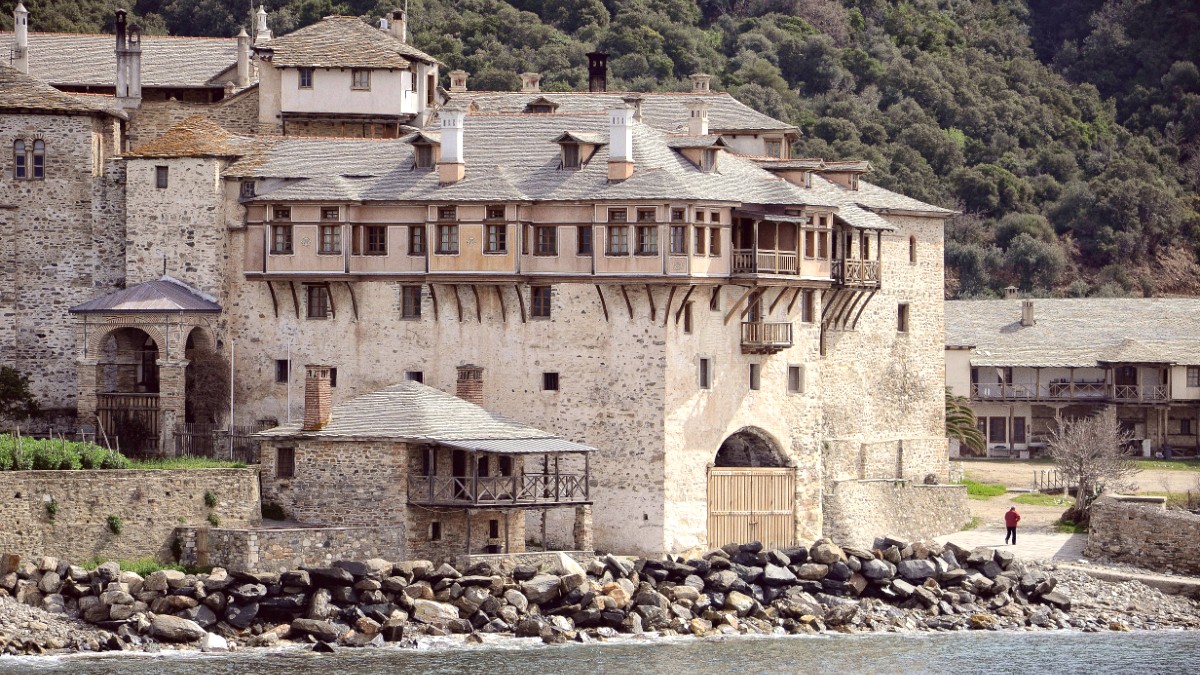
Greece
Mount Athos experiences a Mediterranean climate, characterized by hot, dry summers and mild, wet winters. Temperatures in Summer (June-August) average 25-30°C (77-86°F), with high humidity and minimal precipitation. Autumn (September-November) sees temperatures of 15-25°C (59-77°F), with increasing rainfall in late autumn.
Winter (December-February) temperatures average 5-15°C (41-59°F). This is the wettest period, with the highest precipitation. Occasional snowfall occurs on the peak of Mount Athos. Spring (March-May) temperatures average 10-20°C (50-68°F), offering fresh air and moderate rainfall.
For hiking or walking, Spring (April-May) and Autumn (September-October) offer the most comfortable temperatures and scenic conditions. The air is clear, and natural beauty stands out. For a spiritual retreat, the low season (winter) may give a more profound, less crowded experience, for those seeking deep spiritual contemplation. Plan for colder weather and possible transport disruptions. This period brings uninterrupted focus on prayer and monastic life.
However, demand for Diamonitiria (permits) sees higher numbers during high season, making it harder to secure one without advance planning. Monastery accommodation also sees higher demand, compelling earlier confirmation. You might encounter more visitors during this time. Rougher sea conditions can lead to ferry cancellations in winter, so build in flexibility.
Non-EU citizens requiring a Schengen visa for Greece apply through their home country's Greek embassy or consulate well in advance. EU citizens do not need a visa for Greece or Mount Athos.
The Diamonitirion is the most important document for entry to Mount Athos. Entry without it is not possible. There are General and Special Diamonitiria.
Contact the Mount Athos Pilgrims' Bureau in Thessaloniki or Ouranoupolis well in advance. Provide passport details, contact information, and proposed dates.
Collect your Diamonitirion in person at the Pilgrims' Bureau in Thessaloniki or Ouranoupolis on your departure day. The fee is generally €35 for non-Orthodox, €25 for Orthodox, and €10 for students.
Immigration procedures happen upon ferry boarding and arrival in Daphne. No formal immigration checks beyond this occur, as Mount Athos operates within the Hellenic Republic.
The Euro (€) serves as the currency. Mount Athos has no ATMs or credit card facilities. You must carry sufficient cash for your entire stay on the peninsula. Exchange currency prior to arriving in Ouranoupolis or Thessaloniki. Secure small denominations (€5, €10, €20 notes) for ferry fares and internal transport.
Monasteries offer hospitality freely, meaning no charge for accommodation or meals. A small voluntary donation is customary and appreciated. Sketes and cells also give free lodging, though usually more basic. Monastic food is typically simple, freshly prepared, and consumed communally, adhering to fasting rules.
Free in monasteries; small voluntary donation appreciated.
Free at monasteries; simple, communal, often vegetarian.
Approximately €8-€10 one-way.
Approximately €5-€10 per person, depending on distance.
€35 non-Orthodox, €25 Orthodox, €10 students.
Mount Athos is a remarkably safe place due to its monastic environment and isolation. However, preparing for common health issues and understanding limited medical access is important. This section details health and safety guidance.
No specific vaccinations apply beyond standard national guidelines for Greece. Consult a healthcare professional for personalized advice. Common health concerns include dehydration, foot blisters from walking, and sunburn. Carry a Reusable water bottle, use well-worn footwear, and apply Broad-spectrum sunscreen.
Healthcare facilities on Mount Athos are extremely limited. A small infirmary in Karyes offers only basic first aid. No hospitals or pharmacies exist within the monastic state. For serious medical emergencies, evacuation to mainland hospitals (e.g., in Thessaloniki) becomes necessary. This has sea and/or land transport, which can take several hours.
Plan your health and safety with the knowledge that medical facilities are limited. Self-reliance, a good first-aid kit, and robust travel insurance give strong protection. Carry a list of important contacts.
To make your pilgrimage smooth, a thorough pre-trip checklist is helpful. Organize your documents, medical supplies, and personal items. This list will guide your preparation.
Original and copies for identification.
Your core entry permit; carry it always.
Policy details and emergency contacts.
Your well-being is important given limited medical facilities on Athos. Pack wisely.
Pack a practical health kit to manage common ailments. This kit includes blister treatments like Moleskin, antiseptic wipes, pain relievers (Ibuprofen or paracetamol), and bandages. Antihistamines for allergies or insect bites are useful. Always carry personal prescription medications in original packaging, along with a copy of the prescription or doctor's note.
Consider Motion sickness medication for ferry journeys, especially in rough seas. High SPF sunscreen, a wide-brimmed hat, and Sunglasses offer sun protection. Insect repellent protects against mosquitoes and other insects.
A Water purification filter bottle or Tablets give a backup for safe drinking water, though monastery water is generally good.
No ATMs or card facilities on Mount Athos.
Expect intermittent phone and internet access. Airalo offers eSIM options for global connectivity.
Important for charging devices given limited outlets.
Mount Athos maintains strict rules to preserve its sacred atmosphere. Awareness of these is important for a respectful visit.
This sacred journey offers profound spiritual rewards. Thoughtful planning supports a memorable and respectful experience. Embrace the monastic rhythm and the serene environment.
Adhere to monastic rules and dress codes.
Be ready for unexpected changes in schedules.
Embrace the opportunity for reflection.